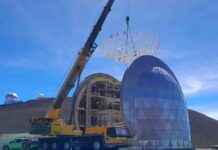SpaceX achieved a significant milestone with the successful launch and catch of the Starship booster in its fifth test flight. The towering rocket, standing at almost 400 feet, took off from Texas and soared over the Gulf of Mexico. Previous test flights had ended in destruction, but the June flight was a step in the right direction with a successful completion.
This time, Elon Musk and his team raised the stakes by bringing the booster back to land at the launch pad using mechanical arms dubbed “chopsticks.” This daring move paid off as the booster was caught by the arms and gently lowered back to the ground. The excitement among SpaceX employees was palpable, with cheers and fist pumps celebrating the historic moment.
Following the successful landing of the booster, the spacecraft atop it made a controlled landing in the Indian Ocean as planned. The real-time decision-making by the flight director played a crucial role in ensuring the safe return of both the booster and the launch tower. The upgraded software and improved heat shield were instrumental in the success of this test flight.
SpaceX’s ability to recover and reuse first-stage boosters has revolutionized the space industry, allowing for faster launch rates and cost savings. The Starship rocket, with its 33 methane-fueled engines, represents a leap forward in space exploration. NASA has already placed orders for Starships to land astronauts on the moon in the coming years, with the ultimate goal of reaching Mars.
The successful test flight of the Starship booster marks a significant advancement in SpaceX’s quest for space exploration. As the company continues to push the boundaries of what is possible, the future looks promising for manned missions to the moon and beyond. With each successful flight, SpaceX is one step closer to making science fiction a reality.



























